Spillover Effects of Mega-Events: The Influences of Residence, Transportation Mode, and Staying Period on Attraction Networks during Olympic Games
Abstract
1. Introduction
1.1. Spillover Effects of Mega-Events
1.2. Attraction Compatibility and Multi-Attraction Visits
1.3. Demand-Oriented Evidence of Mega-Event Impact
1.4. Effects of Residences, Transportation Mode, and Staying Period
2. Materials and Methods
2.1. Study Location and Data Collection
2.2. Network Analysis
3. Results
3.1. Comparisons of Centrality and Connecting Strength among Three Pairs of Networks
3.2. Quadratic Assignment Procedure and Network Density Comparison
4. Discussion and Conclusions
Author Contributions
Funding
Acknowledgments
Conflicts of Interest
References
- Vanolo, A. The image of the creative city: Some reflections on urban branding in Turin. Cities 2008, 25, 370–382. [Google Scholar] [CrossRef]
- Gratton, C.; Preuss, H. Maximizing Olympic impacts by building up legacies. Int. J. Hist. Sport 2008, 25, 1922–1938. [Google Scholar] [CrossRef]
- Zhang, L.; Zhao, S.X. City branding and the Olympic effect: A case study of Beijing. Cities 2009, 26, 245–254. [Google Scholar] [CrossRef]
- Chappelet, J.L.; Lee, K.H. The emerging concept of sport-event-hosting strategy: Definition and comparison. J. Glob. Sport Manag. 2016, 1, 34–48. [Google Scholar] [CrossRef]
- Kasimati, E.; Dawson, P. Assessing the impact of the 2004 Olympic Games on the Greek economy: A small macroeconometric model. Econ. Model. 2009, 26, 139–146. [Google Scholar] [CrossRef]
- Miyoshi, K.; Sasaki, M. The long-term impacts of the 1998 Nagano Winter Olympic Games on economic and labor market outcomes. Asian Econ. Policy Rev. 2016, 11, 43–65. [Google Scholar] [CrossRef]
- Müller, M. After Sochi 2014: Costs and impacts of Russia’s Olympic Games. Eurasian Geogr. Econ. 2014, 55, 628–655. [Google Scholar] [CrossRef]
- Neirotti, L.D. Impact of Olympic Spectator Satisfaction and Behavioral Intention on Post-Olympic Tourism and Brand Legacies. In Proceedings of the 8th International Sport Business Symposium, Rio de Janeiro, Brazil, 16 August 2016; p. 39. [Google Scholar]
- Bottero, M.; Sacerdotti, S.L.; Mauro, S. Turin 2006 Olympic Winter Games: Impacts and legacies from a tourism perspective. J. Tour. Cult. Change 2012, 10, 202–217. [Google Scholar] [CrossRef]
- Rocha, C.M.; Fink, J.S. Attitudes toward attending the 2016 Olympic Games and visiting Brazil after the games. Tour. Manag. Perspect. 2017, 22, 17–26. [Google Scholar] [CrossRef]
- Vanolo, A. The image of the creative city, eight years later: Turin, urban branding and the economic crisis taboo. Cities 2015, 46, 1–7. [Google Scholar] [CrossRef]
- Yang, Y.; Wong, K.K. A spatial econometric approach to model spillover effects in tourism flows. J. Travel Res. 2012, 51, 768–778. [Google Scholar] [CrossRef]
- Balli, F.; Curry, J.; Balli, H.O. Inter-regional spillover effects in New Zealand international tourism demand. Tour. Geogr. 2015, 17, 262–278. [Google Scholar] [CrossRef]
- Kim. Foreign Case Studies for Post-Management of Olympic Related Public Infrastructure in Gangneung; Local reports. Gangneung-Wonju University: Gangneung, Korea, 2018. [Google Scholar]
- Lue, C.C.; Crompton, J.L.; Fesenmaier, D.R. Conceptualization of multi-destination pleasure trips. Ann. Tour. Res. 1993, 20, 289–301. [Google Scholar] [CrossRef]
- Nelson, R.L. The Selection of Retail Location; R.W. Dodge Corporation: New York, NY, USA, 1958. [Google Scholar]
- Hunt, M.A.; Crompton, J.L. Investigating attraction compatibility in an East Texas City. Int. J. Tour. Res. 2008, 10, 237–246. [Google Scholar] [CrossRef]
- Wall, G. Competition and complementarity: A study in park visitation. Int. J. Environ. Stud. 1978, 13, 35–41. [Google Scholar] [CrossRef]
- Oppermann, M. A model of travel itineraries. J. Travel Res. 1995, 33, 57–61. [Google Scholar] [CrossRef]
- Weidenfeld, A.; Butler, R.W.; Williams, A.M. Clustering and compatibility between tourism attractions. Int. J. Tour. Res. 2010, 12, 1–16. [Google Scholar] [CrossRef]
- Fyall, A.; Leask, A.; Garrod, B. Scottish visitor attractions: A collaborative future? Int. J. Tour. Res. 2001, 3, 211–228. [Google Scholar] [CrossRef]
- Caldeira, A.M.; Kastenholz, E. Spatiotemporal behaviour of the urban multi-attraction tourist: Does distance travelled from country of origin make a difference? Tour. Manag. Stud. 2015, 11, 91–97. [Google Scholar]
- García-Palomares, J.C.; Gutiérrez, J.; Mínguez, C. Identification of tourist hot spots based on social networks: A comparative analysis of European metropolises using photo-sharing services and GIS. Appl. Geogr. 2015, 63, 408–417. [Google Scholar] [CrossRef]
- Jurowski, C.; Combrink, M.S.; Cothran, C. Measuring probabilities in attraction visitation. In Proceedings of the 2007 TTRA International Conference: Tourism Travel and Research Association: Advancing Tourism Research Globally, Amherst, MA, USA, 17–19 June 2016; Available online: https://scholarworks.umass.edu/cgi/viewcontent.cgi?article=1354&context=ttra (accessed on 6 February 2020).
- Kang, S.; Lee, G.; Kim, J.; Park, D. Identifying the spatial structure of the tourist attraction system in South Korea using GIS and network analysis: An application of anchor-point theory. J. Destin. Mark. Manag. 2018, 9, 358–370. [Google Scholar] [CrossRef]
- Lee, S.H.; Choi, J.Y.; Yoo, S.H.; Oh, Y.G. Evaluating spatial centrality for integrated tourism management in rural areas using GIS and network analysis. Tour. Manag. 2013, 34, 14–24. [Google Scholar] [CrossRef]
- Miah, S.J.; Vu, H.Q.; Gammack, J.; McGrath, M. A big data analytics method for tourist behaviour analysis. Inf. Manag. 2017, 54, 771–785. [Google Scholar] [CrossRef]
- Hui, T.K.; Yuen, C.C. A study in the seasonal variation of Japanese tourist arrivals in Singapore. Tour. Manag. 2002, 23, 127–131. [Google Scholar] [CrossRef]
- Butler, R.W. Seasonality in tourism: Issues and implications. Tour. Rev. 2001, 53, 18–24. [Google Scholar] [CrossRef]
- Mutinda, R.; Mayaka, M. Application of destination choice model: Factors influencing domestic tourists’ destination choice among residents of Nairobi, Kenya. Tour. Manag. 2012, 33, 1593–1597. [Google Scholar] [CrossRef]
- Lepp, A.; Gibson, H. Sensation seeking and tourism: Tourist role, perception of risk and destination choice. Tour. Manag. 2008, 29, 740–750. [Google Scholar] [CrossRef]
- Yuan, H.; Xu, H.; Qian, Y.; Li, Y. Make your travel smarter: Summarizing urban tourism information from massive blog data. Int. J. Inf. Manag. 2016, 36, 1306–1319. [Google Scholar] [CrossRef]
- Shih, H.Y. Network characteristics of drive tourism destinations: An application of network analysis in tourism. Tour. Manag. 2006, 27, 1029–1039. [Google Scholar] [CrossRef]
- Liu, B.; Huang, S.S.; Fu, H. An application of network analysis on tourist attractions: The case of Xinjiang, China. Tour. Manag. 2017, 58, 132–141. [Google Scholar] [CrossRef]
- Leung, X.Y.; Wu, B.; Xie, F.; Xie, Z.; Bai, B. Overseas Tourist Movement Patterns in Beijing: The Impact of the Olympic Games Tour. Travel Res. Assoc. 2016. Available online: https://scholarworks.umass.edu/cgi/viewcontent.cgi?article=1573&context=ttra (accessed on 6 February 2020).
- Song, H.; Li, G.; Witt, S.F.; Athanasopoulos, G. Forecasting tourist arrivals using time-varying parameter structural time series models. Int. J. Forecast. 2011, 27, 855–869. [Google Scholar] [CrossRef]
- Decrop, A. Destination choice sets: An inductive longitudinal approach. Ann. Tour. Res. 2010, 37, 93–115. [Google Scholar] [CrossRef]
- Karl, M.; Reintinger, C.; Schmude, J. Reject or select: Mapping destination choice. Ann. Tour. Res. 2015, 54, 48–64. [Google Scholar] [CrossRef]
- Versichele, M.; De Groote, L.; Bouuaert, M.C.; Neutens, T.; Moerman, I.; Van de Weghe, N. Pattern mining in tourist attraction visits through association rule learning on Bluetooth tracking data: A case study of Ghent, Belgium. Tour. Manag. 2014, 44, 67–81. [Google Scholar] [CrossRef]
- Chua, A.; Servillo, L.; Marcheggiani, E.; Moere, A.V. Mapping Cilento: Using geotagged social media data to characterize tourist flows in southern Italy. Tour. Manag. 2016, 57, 295–310. [Google Scholar] [CrossRef]
- Hu, Y.; Gao, S.; Janowicz, K.; Yu, B.; Li, W.; Prasad, S. Extracting and understanding urban areas of interest using geotagged photos. Comput. Environ. Urban Syst. 2015, 54, 240–254. [Google Scholar] [CrossRef]
- Vu, H.Q.; Li, G.; Law, R.; Ye, B.H. Exploring the travel behaviors of inbound tourists to Hong Kong using geotagged photos. Tour. Manag. 2015, 46, 222–232. [Google Scholar] [CrossRef]
- Hanneman, R.A.; Riddle, M. Introduction to Social Network Methods; University of California Riverside: Riverside, CA, USA, 2005; Available online: https://faculty.ucr.edu/~hanneman/nettext/Introduction_to_Social_Network_Methods.pdf (accessed on 6 February 2020).
- Granovetter, M. American journal of sociology. The strength of Weak Ties. 1973. Available online: https://sociology.stanford.edu/sites/g/files/sbiybj9501/f/publications/the_strength_of_weak_ties_and_exch_w-gans.pdf (accessed on 6 February 2020).
- Czernek-Marszałek, K. Cooperation evaluation with the use of network analysis. Ann. Tour. Res. 2018, 72, 126–139. [Google Scholar] [CrossRef]
- Kim, E.J.; Jo, Y.; Kang, Y. Are Touristic Attractions Well-Connected in an Olympic Host City? A Network Analysis Measurement of Visitor Movement Patterns in Gangneung, South Korea. Sustainability 2018, 10, 3310. [Google Scholar] [CrossRef]
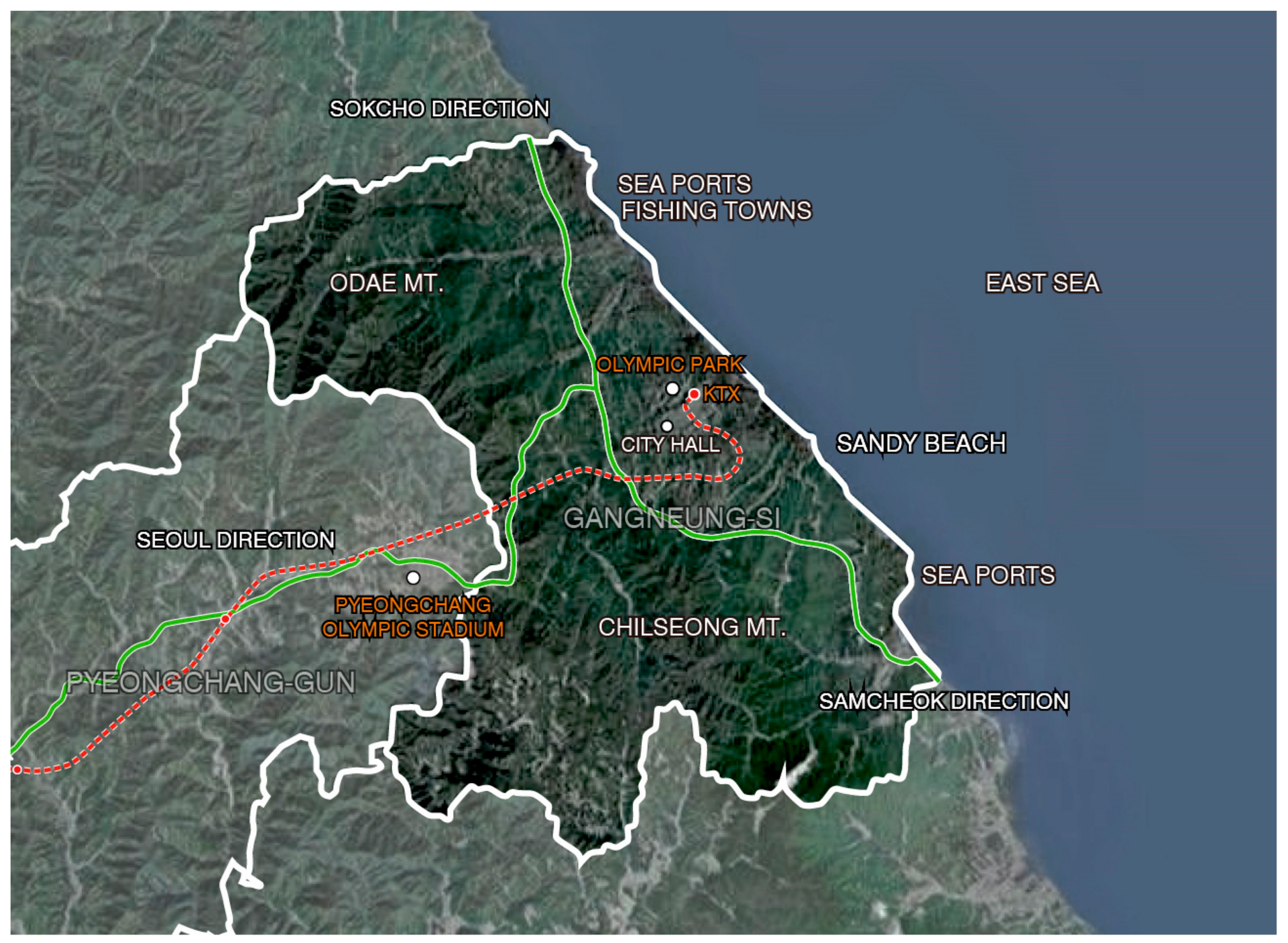
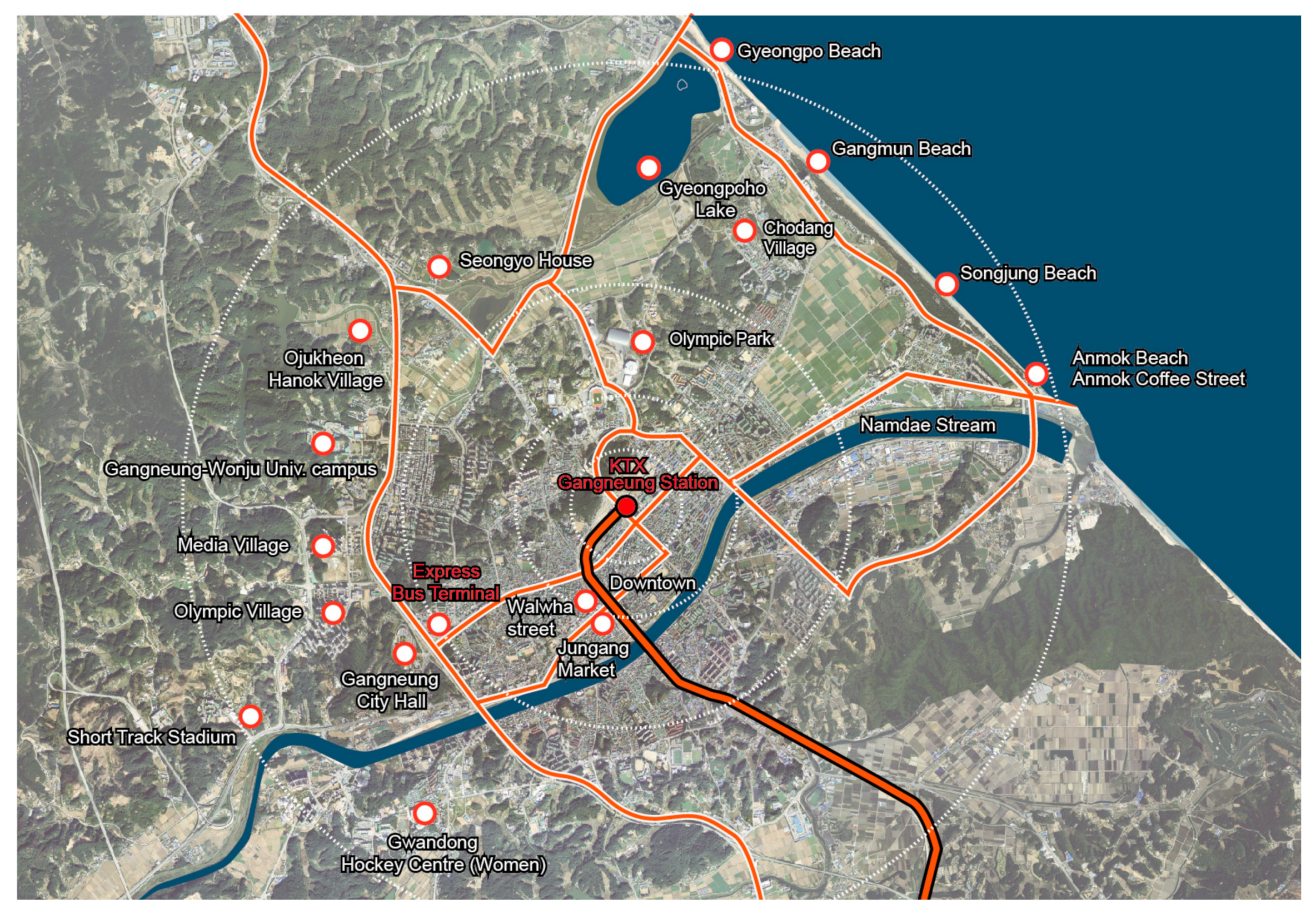
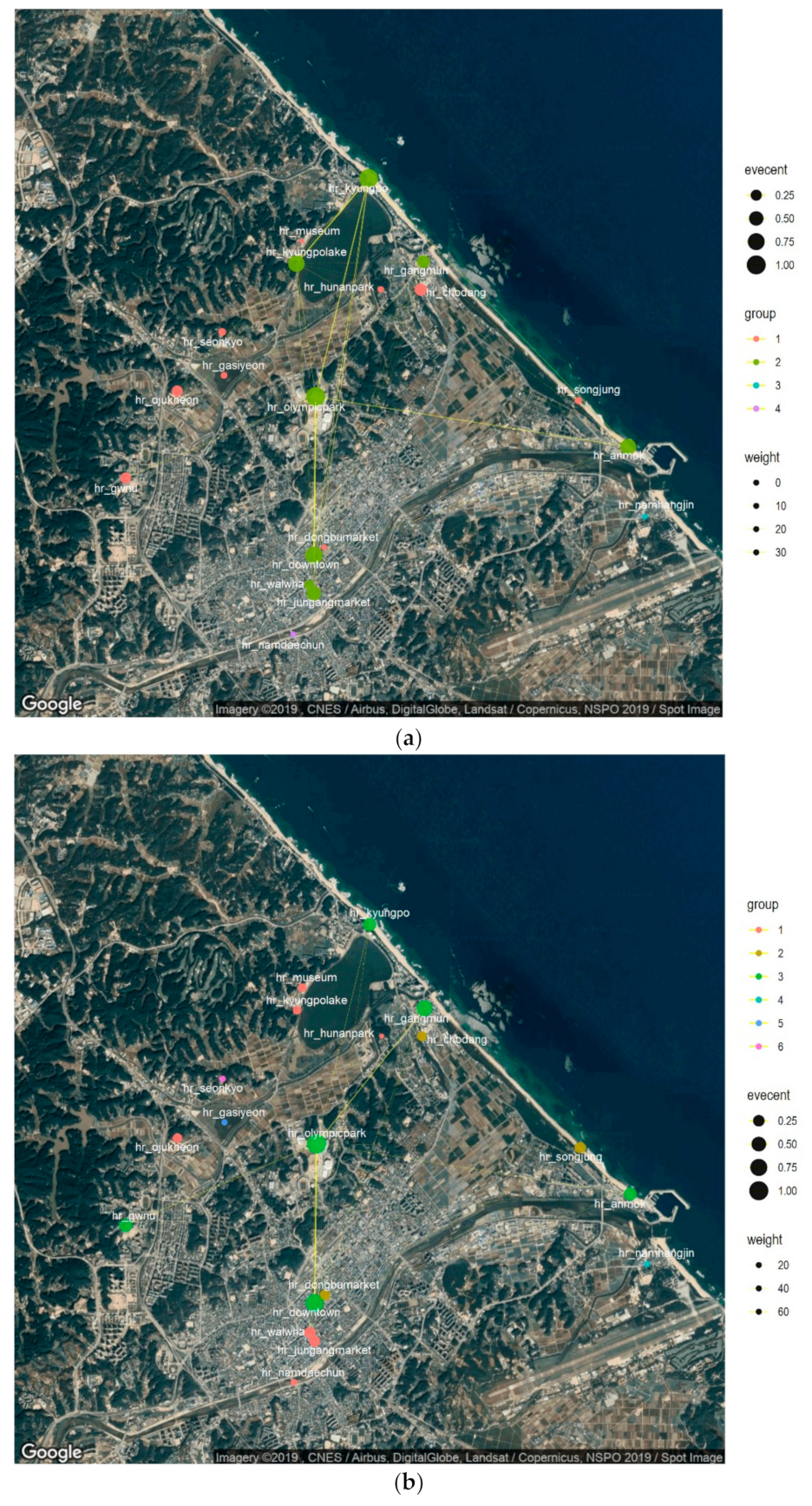
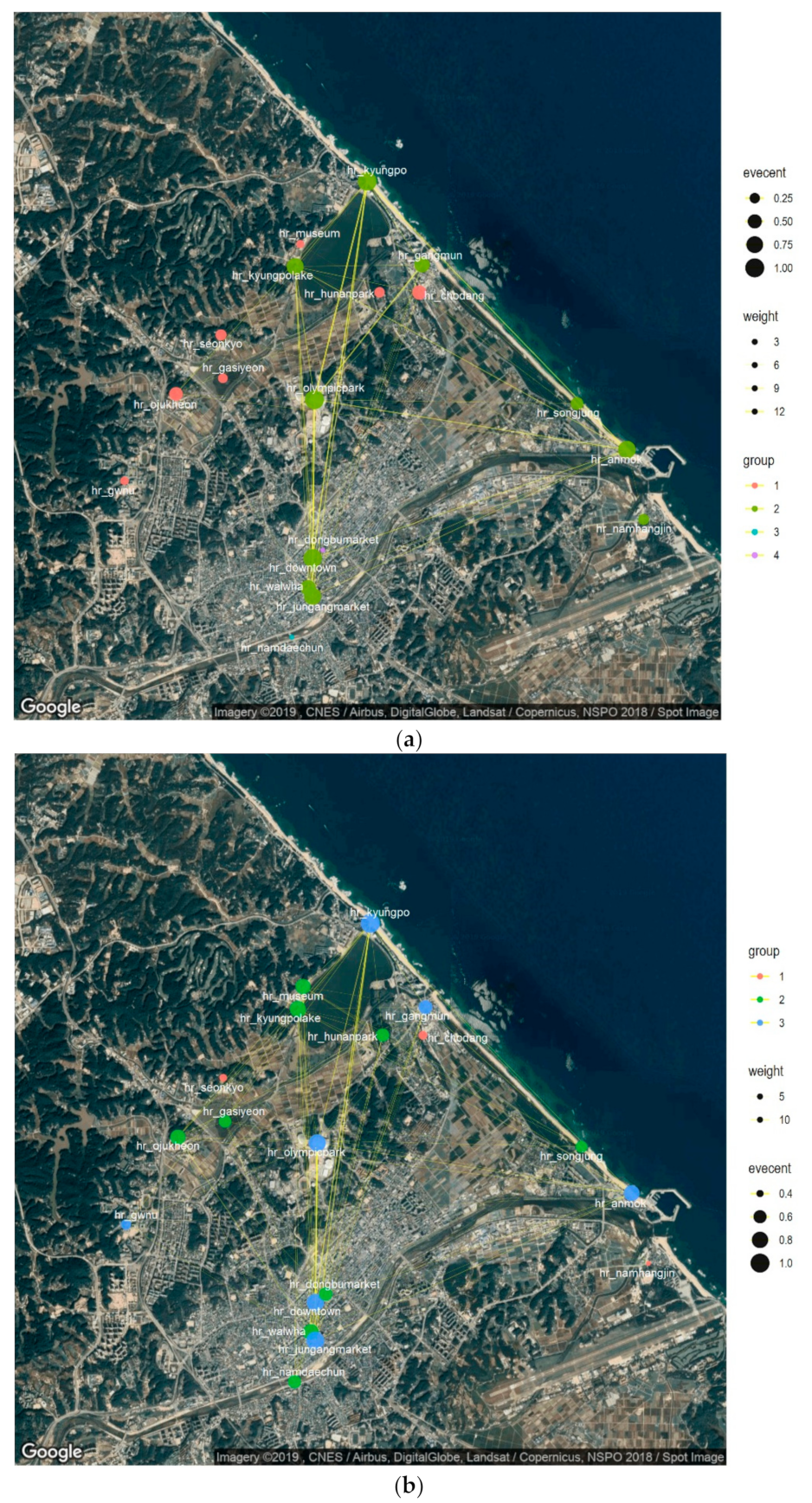
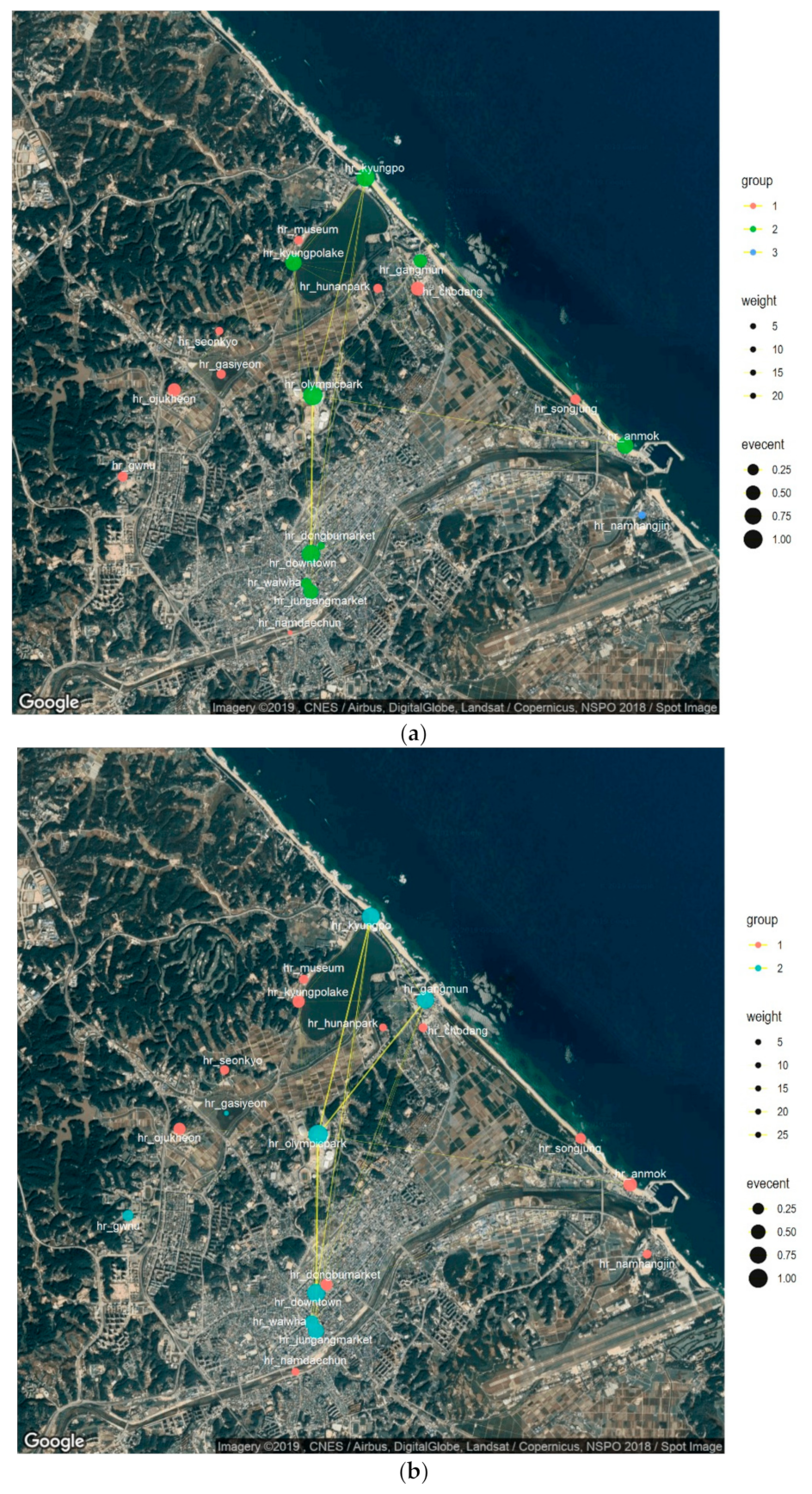
| Participant Characteristic | Number | Percent | |
|---|---|---|---|
| Residence | Domestic | 67 | 44% |
| Foreign | 85 | 56% | |
| Gender | Male | 81 | 53% |
| Female | 70 | 46% | |
| N/A | 1 | 1% | |
| Age | < 20 years | 2 | 1% |
| 20–39 years | 86 | 57% | |
| 40–59 years | 49 | 32% | |
| > 60 years | 15 | 10% | |
| Transportation mode in city | Car/taxi | 43 | 28% |
| Public transportation/walking | 55 | 36% | |
| Mixed use | 54 | 36% | |
| Staying period | One or two nights | 64 | 42% |
| Three or more nights | 71 | 47% | |
| N/A | 17 | 11% | |
| Total participants | 152 | 100% | |
| Eigenvalue Degree Centrality (Staying Time Considered) | ||||||
|---|---|---|---|---|---|---|
| Attraction | Domestic | Foreign | Car/Taxi | Public Transport/Walking | One or Two Nights | Three or More Nights |
| Kyungpo Beach | 0.934444 | 0.35993 | 0.955691 | 1 | 0.861393 | 0.791901 |
| Gangmun Beach | 0.340817 | 0.59937 | 0.591384 | 0.635672 | 0.365689 | 0.726931 |
| Sonjung Beach | 0.078229 | 0.21846 | 0.368821 | 0.527281 | 0.163637 | 0.174486 |
| Anmok Beach | 0.617688 | 0.331659 | 0.819011 | 0.750905 | 0.650865 | 0.363796 |
| Namhangjin Port | 0.060551 | 0.032196 | 0.26943 | 0.378615 | 0.075264 | 0.0882 |
| Museums | 0.057634 | 0.087003 | 0.145824 | 0.694591 | 0.101438 | 0.099425 |
| Kyungpo Lake | 0.679494 | 0.082685 | 0.742647 | 0.759233 | 0.64206 | 0.277796 |
| Huhnansulheon Park | 0.070417 | 0.023923 | 0.243056 | 0.587828 | 0.122358 | 0.056042 |
| O-jukhun | 0.224594 | 0.119217 | 0.43601 | 0.699387 | 0.346758 | 0.261478 |
| Chodang Village | 0.302817 | 0.145734 | 0.48609 | 0.423542 | 0.413624 | 0.087904 |
| Olympic Park | 1 | 1 | 1 | 0.846246 | 1 | 1 |
| Gasiyeon | 0.076168 | 0.032196 | 0.205948 | 0.561281 | 0.129407 | 0.015152 |
| GWNU campus | 0.22719 | 0.334725 | 0.15741 | 0.471832 | 0.165262 | 0.181666 |
| Walwha Street | 0.176332 | 0.226011 | 0.587807 | 0.730986 | 0.18319 | 0.388288 |
| Downtown | 0.789736 | 0.825471 | 0.905944 | 0.868126 | 0.851848 | 0.793993 |
| Namdae River | 0.060551 | 0.039614 | 0.101872 | 0.587828 | 0.03838 | 0.056042 |
| Dongbu Market | 0.062668 | 0.176735 | 0.101872 | 0.587828 | 0.064704 | 0.262004 |
| Jungang Market | 0.487788 | 0.19022 | 0.776523 | 0.910418 | 0.489904 | 0.532685 |
| Seonkyo House | 0.090892 | 0.032196 | 0.274219 | 0.403217 | 0.081932 | 0.107784 |
| Independent Variable | Domestic | Foreign | Car/Taxi | Public Transport/Walking | One or Two Nights | Three or More Nights |
|---|---|---|---|---|---|---|
| Region proximity | 0.0182 (0.9869) | −0.0023 (1.4644) | −0.0254 (0.8340) | 0.0561 (0.9182) | 0.0319 (1.1848) | −0.0319 (2.4046) |
| p-value | 0.3448 | 0.5647 | 0.4528 | 0.2289 | 0.2969 | 0.3998 |
| Type proximity | 0.0144 (0.7688) | −0.0569 (1.2172) | 0.008 (0.6398) | −0.0203 (0.7391) | 0.0014 (0.9163) | −0.0499 (1.8387) |
| p-value | 0.3698 | 0.1849 | 0.4063 | 0.4318 | 0.0014 | 0.2064 |
| Adjusted R2 | −0.005 | −0.003 | −0.005 | −0.003 | −0.005 | −0.001 |
| No. of Obs. | 342 | |||||
| Bootstrap Paired Sample t-test (Based on the Same Nodes) | |||||
|---|---|---|---|---|---|
| Network Density | Difference in Density | t-Statistic | Classical Standard Error of Difference (Bootstrap Standard Error of Difference) | Proportion of Absolute Differences as Large as Those Observed (One-Tailed p-Value) | |
| Travel type based on visitors’ residences | |||||
| Domestic travel | 2.6959 | −0.4678 | −0.6264 | 0.4986d (1.3359) | 0.5217 (0.2609) |
| Foreign travel | 3.1637 | ||||
| Transportation mode | |||||
| Car/taxi | 2.6637 | −0.8216 | −2.3918 | 0.3322 (0.8798) | 0.0166 (0.0083 *) |
| Public transport/walking | 3.4854 | ||||
| Staying period | |||||
| One or two nights | 2.4854 | −2.9064 | −2.4254 | 0.7161 (1.9527) | 0.0172 (0.0086 *) |
| Three or more nights | 5.3918 | ||||
© 2020 by the authors. Licensee MDPI, Basel, Switzerland. This article is an open access article distributed under the terms and conditions of the Creative Commons Attribution (CC BY) license (http://creativecommons.org/licenses/by/4.0/).
Share and Cite
Kim, E.-J.; Kang, Y. Spillover Effects of Mega-Events: The Influences of Residence, Transportation Mode, and Staying Period on Attraction Networks during Olympic Games. Sustainability 2020, 12, 1206. https://doi.org/10.3390/su12031206
Kim E-J, Kang Y. Spillover Effects of Mega-Events: The Influences of Residence, Transportation Mode, and Staying Period on Attraction Networks during Olympic Games. Sustainability. 2020; 12(3):1206. https://doi.org/10.3390/su12031206
Chicago/Turabian StyleKim, Eujin-Julia, and Youngeun Kang. 2020. "Spillover Effects of Mega-Events: The Influences of Residence, Transportation Mode, and Staying Period on Attraction Networks during Olympic Games" Sustainability 12, no. 3: 1206. https://doi.org/10.3390/su12031206
APA StyleKim, E.-J., & Kang, Y. (2020). Spillover Effects of Mega-Events: The Influences of Residence, Transportation Mode, and Staying Period on Attraction Networks during Olympic Games. Sustainability, 12(3), 1206. https://doi.org/10.3390/su12031206




